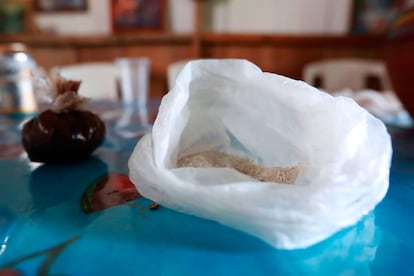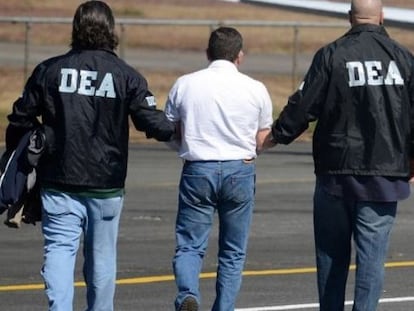A journey to the home of fentanyl, the drug that killed Prince
EL PAÍS finds that production of a substance 50 times stronger than heroin has spread through the Mexican state of Guerrero

It killed Prince, and before that it killed hundreds of his fellow Americans. Fentanyl is a synthetic opioid that can be 50 times more powerful than heroin. For years, China headed illegal production of the drug, but the business is now making inroads in Mexico as well. EL PAÍS has found that fentanyl is being made in the heart of the state of Guerrero, which is already the epicenter of opium production in the Americas and one of the main platforms for drug distribution to the United States.

Filo de Caballos is a hamlet stuck in the backbone of the Guerrero mountains. There are 900 residents and no cellphone reception. On these steep hillsides, far from the Mexican army’s prying eyes, practically nothing happens without the drug bosses knowing about it.
Yet this impoverished and overlooked territory is crucial to the drug cartels. It’s not just because of the opium that is grown here; it’s also because of its links to the US-bound routes. To these two factors, a revolutionary new element must now be added: fentanyl.
A trip to the Guerrero highlands provides evidence of its expansion. There is hardly an opium grower around who is not familiar with it. Aware that fentanyl is opening the doors of an explosive new market, they discuss the drug with expert attitudes and, if necessary, show it off along with the more traditional opium latex.
Aware that fentanyl is opening the doors of an explosive new market, growers discuss the drug with expert attitudes
We are sitting inside a small eatery. Someone has brought the fentanyl wrapped inside a small plastic bag that is carefully deposited on the table. It is an unpleasant light beige in color. The farm workers explain that it has been mixed with heroin. One of them, speaking with an excess of self-confidence, notes that they produce it themselves right here in the mountains of Guerrero.
The small package exudes an intense smell of medicine. It is lunchtime, and a dozen locals are standing nearby. Nobody seems surprised at seeing the devilish substance thus displayed in public; instead, they seem to feel reverence for what it is worth. And while this reporter is allowed to handle the thick opium latex freely, he is asked to exercise extreme caution with the fentanyl, which cannot be removed from its spot on the table.
“This is the most powerful thing in the world,” he is told.
Sign up for our newsletter
EL PAÍS English Edition has launched a weekly newsletter. Sign up today to receive a selection of our best stories in your inbox every Saturday morning. For full details about how to subscribe, click here.
Originally created as a potent painkiller for terminal cancer patients, the recreational use of fentanyl has been growing to the point of becoming a nightmare for US authorities. Nearly 700 people have died there in just one year, yet consumption is on the rise.
The first shipments used to come in from China, leading to its other name of China White. The drug cartels soon got wind of its penetration in the US. Although its starting price is similar to heroin – around $5,000 a kilogram – its explosive potency means that it can be adulterated in multiple ways, increasing profits twentyfold compared with opium.
Attracted by this enormous margin, Mexico’s criminal organizations began to import it from the East in order to introduce it into the US themselves. Sometimes fentanyl was delivered pure, sometimes mixed with heroin.
“It is not aimed at Mexican consumers, who demand heroin, but is meant for US consumption,” explains Antonio Mazzitelli, the representative for the United Nations Office on Drug and Crime.

Once the delivery channels were under control, the next step was to begin homemade production. There are few available figures to work with. The US Drug Enforcement Administration has detected a flow of chemical precursors to Mexico and has tracked down laboratories in Nayarit, Colima and Guerrero. The greatest seizure on Mexican territory took place last year in Sinaloa, where police found 25 kilograms of fentanyl and 19,000 pills of oxycodone, an opioid painkiller, in the hands of operators working for the drug lord El Chapo Guzmán.
Since then, there has been a trickle of uncovered shipments and small seizures – the latest one took place last week, when authorities cracked down on hired killers who had assassinated three federal police officers in Chilapa (Guerrero).
It is highly likely that small cartels in Guerrero are exporting fentanyl directly and selling it to US distributors
Antonio Mazzitelli, US Center on Drug and Crime
But the main thing, say police sources, is not so much the finished product or the eternal cat-and-mouse chases to seize it. Rather, the thing to ask is where, how and for whom fentanyl is being made.
“Mexico has started producing it in order to send it to its northern neighbor, and it is highly likely that small cartels in Guerrero are exporting fentanyl directly and selling it to US distributors,” says Mazzitelli.
Choosing the mountains of Guerrero as a launchpad was a strategic decision. Located in the heart of one of the most violent states in all of Mexico, yet just 250 kilometers from Mexico City, this is a lawless land where police and military pressure is kept at a bare minimum. Massive opium cultivation has created highly specialized infrastructures for the production of heroin, which can now be easily adapted to fentanyl. Here, in Guerrero, production can take place on a large scale, free of police interference – ready to travel into the heart of the United States.
English version by Susana Urra.
Tu suscripción se está usando en otro dispositivo
¿Quieres añadir otro usuario a tu suscripción?
Si continúas leyendo en este dispositivo, no se podrá leer en el otro.
FlechaTu suscripción se está usando en otro dispositivo y solo puedes acceder a EL PAÍS desde un dispositivo a la vez.
Si quieres compartir tu cuenta, cambia tu suscripción a la modalidad Premium, así podrás añadir otro usuario. Cada uno accederá con su propia cuenta de email, lo que os permitirá personalizar vuestra experiencia en EL PAÍS.
¿Tienes una suscripción de empresa? Accede aquí para contratar más cuentas.
En el caso de no saber quién está usando tu cuenta, te recomendamos cambiar tu contraseña aquí.
Si decides continuar compartiendo tu cuenta, este mensaje se mostrará en tu dispositivo y en el de la otra persona que está usando tu cuenta de forma indefinida, afectando a tu experiencia de lectura. Puedes consultar aquí los términos y condiciones de la suscripción digital.
More information
Archived In
Últimas noticias
Most viewed
- Alain Aspect, Nobel laureate in physics: ‘Einstein was so smart that he would have had to recognize quantum entanglement’
- Mexico’s missing people crisis casts a shadow over World Cup venue
- Why oil has been at the center of Venezuela-US conflicts for decades
- Trump clarifies who is ultimately in charge in Venezuela: ‘Me’
- Mexico seeks to shore up its defenses following US incursion in Venezuela










































